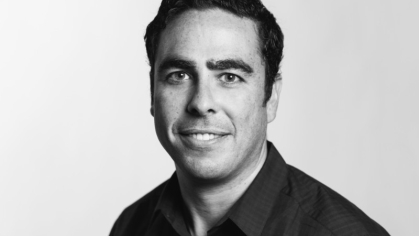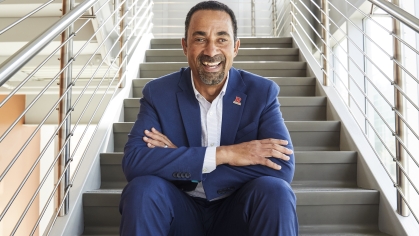“I’m a lucky dude. I owe Rutgers, my alma mater for giving me a solid foundation for my career in the medical technology industry.” -- Vasant Padmanabhan
Vasant Padmanabham holds a doctoral degree from Rutgers in biomedical engineering, and an MBA from the University of Minnesota’s Carlson School of Management. A medical technology executive with more than 25 years of global leadership in delivering business results and innovative pipelines in several medical technology segments, he serves today as the president, Global R&D and ENT Business of a FTSE 100 medical technology company Smith+Nephew plc. Prior to this role, he was senior vice president of technical operations at Thoratec Corporation, a leader in mechanical circulatory support solutions for treating heart failure. Before Thoratec, he spent 18 years at Medtronic, where he held several leadership positions in R&D and operations.
Congratulations on your School of Engineering Medal of Excellence Distinguished Engineer Award! What does this honor mean to you?
It’s a great honor. I’m very happy and very humbled.
What attracted you to biomedical engineering?
I studied electrical engineering as an undergraduate in India. At that time, I took a course on human anatomy and physiology. There is no other electrical, mechanical, or chemical system as complex as the human body. So, I became really fascinated with how the human body works and how to apply electrical engineering principles to help solve problems when the body breaks down. Early in my career, I was interested in pacemakers, which work electrically to help the heart function properly.
What drew you to Rutgers Engineering for your master’s and PhD degrees?
I came to the US when I was 21 years old, right after I finished my undergraduate education. I started at Johns Hopkins, but I soon transferred to Rutgers, when BME professor John Semmlow hired me as a research assistant on an exciting project.
He was more than my professor – he was like a father figure to me, and will be my special guest at the Medal of Excellence gala. I consider myself a very fortunate student to have met and received guidance, mentoring, and teaching all in one from him. He not only gave me an opportunity to get my PhD, but also a strong foundation for my career.
How was your Rutgers experience?
I’m fortunate to have had a very seamless experience: I graduated with my PhD fairly quickly, partly because of my rapport with Dr. Semmlow and partly because everything I did from day one contributed to my doctoral research. I had awesome lab mates, Dr. Alan Smith, Dr. Metin Akay and Russell Fisher to name a few. I got great support from professors John Kostis and Walter Welkowitz, my thesis advisors, as well as other professors in the Department of Biomedical Engineering.
What was the project you worked on at Rutgers?
The project was exciting and applicable to real life – and took my casual interest in BME and turned it into a full-fledged immersion that has driven me to make an impact in the lives of patients.
We put microphones on the chests of patients going in for angioplasty at Robert Wood Johnson Medical School. We came up with a non-invasive way – that didn’t involve putting a catheter in the heart – using electrical engineering techniques to identify blockages in the heart from heart sounds. The technique we worked on was to give an early warning screening to people at risk of heart disease. A company is bringing that product to market now.
Why did you pursue your MBA?
I joined industry as a research scientist, as many PhDs do. At some point, I became interested in the business side of things, so I enrolled as a part-time student at the University of Minnesota’s Carlson School of Management.
Can you describe your current role at Smith+Nephew?
The company was founded 170 years ago by TJ Smith in the UK and his nephew, hence its name. I have two jobs. As head of R&D for the entire company, I lead a group of 800 people worldwide and am responsible for our innovation pipeline. My other job is to lead our Global Ear Nose and Throat (ENT) worldwide business.
Which of your accomplishments there are you most proud of?
My company has developed CORI, a robotic platform that’s used all over the world to help surgeons with joint replacement surgery. There are many such products that I have been part of, but I’m most proud of the talent I’ve mentored, and helped develop over the course of my career. It all comes back to Professor John Semmlow and several other mentors and coaches who have believed in me. I want to do for others what they did for me: hire young talented people and help them meet their full potential. Engineers can always point to a product they created, but that is dwarfed when compared to the people whose talent you have developed.
What is Smith+Nephew looking forward to in terms of R&D?
Smith+Nephew has developed awesome technologies and products with the goal of Life Unlimited. These products attempt to remove limits, physical or mental, from our patients’ lives. An example of our R&D focus is on wound management. There are three big types of wounds that ail people – diabetic foot ulcers: pressure ulcers or bed sores, and venous leg ulcers. These chronic, hard-to-manage wounds cost billions of dollars. I’m proud and excited that at Smith+Nephew, healing wounds is a big part of our business,
We’re also using machine learning and AI to help surgeons do surgery in more predictable and accurate ways. And in a third area, Tula, is placing ear tubes in children without general anesthesia – so children can sit right in their moms’ laps and receive ear tubes.
How would you describe your leadership style?
I have been told that humility and accountability are my strengths. I’m almost never the smartest person in the room, but I enjoy bringing diverse thoughts and opinions into a strategy and driving execution.
What do you most value about your SoE education?
I had the opportunity to develop my hands-on engineering skills, which have been invaluable to me throughout my career.
What is your favorite memory from your Rutgers student days?
John Semmlow had a stick shift Toyota Celica. When he traveled, we made an agreement that I could use his car, but I didn’t drive a stick shift. I learned on his brand-new Toyota on my drive from Newark Airport to New Brunswick.
Do you have any advice for today’s engineering students?
I’d say the human body is a work of art, and a beautiful and complex system. I’d encourage biomedical engineers, to cover as many parts and systems in the human body they can, to make full use of their knowledge to help mankind. Our time in this world is short; biomedical engineers should use every minute they have to help as many people as possible.
If you could go on vacation tomorrow, where would you go?
Portugal is at the top of my list, and I hope to take my family next spring. I’d also like to take an African safari.


